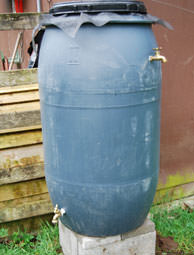One of our new rain barrels. |
After our dry, sunny late winter and early spring spoiled us rotten, we’re back to spring weather as usual here in western Washington.
I have to admit, at this moment I’m not feeling ultra-enthusiastic about the return of the rain, even though I know we need April showers to bring May flowers, and I know it would be a huge pain if our well ran dry this summer, and I know how crucial water is for sustaining our crops, our livestock, and us. Oh, and don’t forget the rest of life here on Earth, too.
I know all of this, but right now I just really, really want to garden with the sun on my back and without wallowing in mud.
Looking on the bright side, however, I do feel pretty enthusiastic about another project my husband crossed off THE LIST a few days ago: installing two plastic rain barrels to catch the copious quantities of rainwater flowing off our house and pump house roofs.
For a few years now, we’ve been catching rain off the horse/sheep barn and pump house roofs with metal wash tubs, and using it to water the animals and our fruit trees.
 Our blossoming apple tree. |
This practice conserves fresh, potable water and the electricity it takes to run our pump, plus helps cut down on rain run-off which carries soil sediment and manure nutrients into local waterways. We’ve also found catching rainwater actually saves us a bit of time spent wrestling hoses (dip the bucket, carry, pour). Now, we can catch and store more water in the barrels and, because they’re outfitted with spigots, attach a hose to irrigate garden plants.
This summer, we’d like to install two more aesthetically-pleasing wine keg rain barrels under the downspouts in front of our house, too.
I know it might sound odd—trying to conserve water in a place where it pours from the sky a good chunk of the year.
But the more I learn about this precious resource, and about the impacts that growing populations, droughts, and other factors are having on water supplies around the world, the more guilty I feel about wasting it.
Here are just a few sobering water facts, gleaned from the April 2010 special water issue of National Geographic:
• Only 2.5 percent of the Earth’s water is fresh, and nearly 70 percent of this is frozen. Salt-water makes up the majority of water on Earth.
• While Americans use on average about 100 gallons of water a day, millions of poor people in developing countries survive on fewer than 5 gallons.
• World-wide, one out of eight people lacks access to clean water.
• In 15 years, it’s predicted 1.8 billion people will live in regions of severe water scarcity.
~ Cherie

















